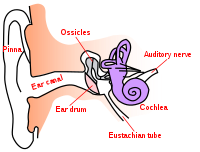
Photo from wikipedia
Abstract Background Detailed studies have not been conducted on sound localization and speech perception in noise in patients with unilateral congenital aural atresia (UCAA). Aims/objectives To evaluate the benefits of… Click to show full abstract
Abstract Background Detailed studies have not been conducted on sound localization and speech perception in noise in patients with unilateral congenital aural atresia (UCAA). Aims/objectives To evaluate the benefits of the use of the Vibrant Soundbridge (VSB) for UCAA by performing audiometric and sound localization tests. Materials and methods Four children with UCAA underwent VSB (VORP 503) implantation from 2018 to 2019. Speech perception tests in noise were conducted using the Japanese monosyllable test. The spatial configuration for speech testing consisted of speech presented from the front and noise presented into the normal ear (S0N90). The sound localization test was conducted using nine loudspeakers equally distributed in a semicircle. Results The children’s speech perception in noise 6 months after VSB activation was significantly better than before activation (p < .05). Additionally, the children’s sound localization ability after VSB activation was significantly better than before VSB activation. Conclusion and significance The benefits of VSB use in children with UCAA were revealed using audiometric and sound localization tests.
Journal Title: Acta Oto-Laryngologica
Year Published: 2020
Link to full text (if available)
Share on Social Media: Sign Up to like & get
recommendations!